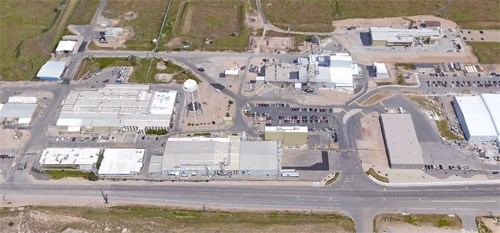The vexing economics of carbon fiber manufacturing
Hexcel's VP and GM Americas, Mike Canario, reviews tough economics the govern carbon fiber manufacturing today, and how they might affect future supply.

This carbon fiber manufacturing facility in Salt Lake City, UT, US, is one of several operated by Hexcel. Hexcel's VP and GM Americas, Mike Canario, talked at CW's Carbon Fiber 2014 conference last week and noted the numerous economic challenges associated with carbon fiber manufacturing expansion.
Mike Canario, VP and GM Americas at carbon fiber manufacturer Hexcel (Stamford, CT, US), spoke at CompositesWorld's Carbon Fiber 2014 conference in La Jolla, CA, US, last week, addressing opportunities and challenges associated with being a supplier of carbon fiber to the composites industry.
Canario provided a rare and frank glimpse of the economics of carbon fiber production and offered revealing insights about how Hexcel sees the market and calculates when and how to expand capacity to meet market demand for carbon fiber.
Carnario noted first that since the mid-1980s, carbon fiber demand in the aerospace industry has been fueled by a variety of important but relatively low-volume military programs, including the B-2, V-22, F-22 and F-35. On the commercial aircraft side, carbon fiber has seen limited use on a variety of Boeing and Airbus planes for many years, but it wasn't until the Boeing 787 and the Airbus A350 XWB were developed that carbon fiber firmly established its place in the aerospace industry. Each plane features carbon fiber in every major structural component (wings to fuselage to tail) and together, at full-rate production, said Canario, will consume more carbon fiber in one year than the F-35 program will over its entire life.
Looking ahead, through 2018, Canario said carbon fiber is expected to growth healthily in ever major market:
- Sports and leisure: 5.7% CAGR (compound annual growth rate)
- Aerospace: 10% CAGR
- Industrial: 14.4% CAGR
- Overall: 12.3% CAGR
What does this mean? Canario said the industry should expect 40,000 metric tons of additional carbon fiber demand in the next five years.
Good, right? Well, yes and no. In short, said Canario, carbon fiber ramp-up is not cheap. Carbon fiber manufacturing requires a polyacrylonitrile (PAN) precursor, the expense of which is exacerbated by the fact that it takes 2 kg of PAN to produce 1 kg of carbon fiber. Further, the high-temperature ovens used to convert PAN to carbon fiber are energy- and capital-intensive. Finally, construction and commissioning of a new carbon fiber plant can take 12 to 18 months, which prolongs return on capital expansion investment.
The real question, Canario said, is this: "Can the current carbon fiber economic model work?" For emphasis, he noted the following costs to manufacture the two basic types of carbon fiber:
- Aerospace grade: $85,000 to $220,000 per metric ton
- Industrial grade: $25,000 to $95,000 per metric ton
Given the current economic model, Canario noted, a carbon fiber manufacturer will expand capacity only if a sustainable rate of return can be guaranteed. This means minimizing risk and capital costs and emphasizing long-term contracts — like that which Toray has with Boeing for the 787 and Hexcel has for the A350 XWB.
For the future, Canario listed several factors that he expects will influence the type and quantity of carbon fiber on the market:
- Alternatives to PAN being developed might prove viable, but will trade performance for cost
- Capital costs will become increasingly important and challenging and will drive much capacity expansion decision-making
- Full use of carbon fiber assets will be the only way to perpetuate the current economic model
- Qualification of carbon fibers for aerospace is time-intensive and represents asset underuse.
"Under-utilized assets are the scariest thing for carbon fiber makers," Canario said.
Related Content
PEEK vs. PEKK vs. PAEK and continuous compression molding
Suppliers of thermoplastics and carbon fiber chime in regarding PEEK vs. PEKK, and now PAEK, as well as in-situ consolidation — the supply chain for thermoplastic tape composites continues to evolve.
Read MoreCryo-compressed hydrogen, the best solution for storage and refueling stations?
Cryomotive’s CRYOGAS solution claims the highest storage density, lowest refueling cost and widest operating range without H2 losses while using one-fifth the carbon fiber required in compressed gas tanks.
Read MoreCarbon fiber in pressure vessels for hydrogen
The emerging H2 economy drives tank development for aircraft, ships and gas transport.
Read MoreMaterials & Processes: Composites fibers and resins
Compared to legacy materials like steel, aluminum, iron and titanium, composites are still coming of age, and only just now are being better understood by design and manufacturing engineers. However, composites’ physical properties — combined with unbeatable light weight — make them undeniably attractive.
Read MoreRead Next
Composites end markets: Energy (2024)
Composites are used widely in oil/gas, wind and other renewable energy applications. Despite market challenges, growth potential and innovation for composites continue.
Read MoreCW’s 2024 Top Shops survey offers new approach to benchmarking
Respondents that complete the survey by April 30, 2024, have the chance to be recognized as an honoree.
Read MoreFrom the CW Archives: The tale of the thermoplastic cryotank
In 2006, guest columnist Bob Hartunian related the story of his efforts two decades prior, while at McDonnell Douglas, to develop a thermoplastic composite crytank for hydrogen storage. He learned a lot of lessons.
Read More






















